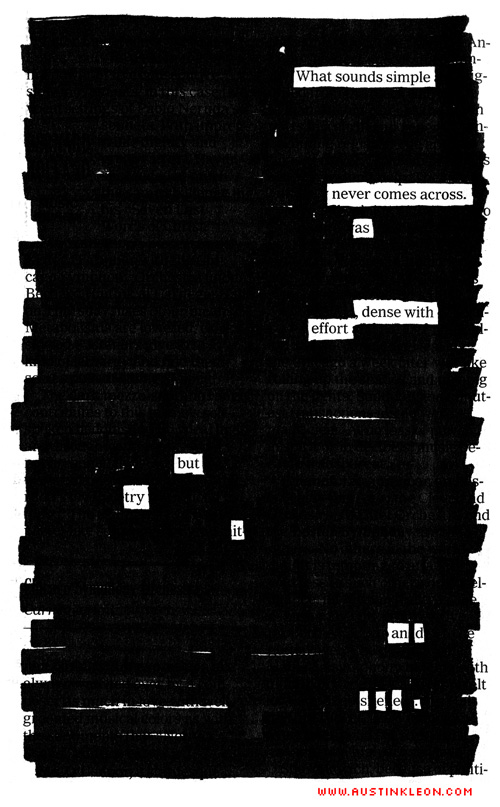
MODERN ART = I COULD DO THAT + YEAH, BUT YOU DIDN’T—“Modern Art” from More New Math by Craig Damrauer
It’s said in different sentences.
“An idea so simple I can’t believe nobody thought of it before.”
“I could’ve done that.”
“Any idiot could do that.”
“I’m sure you’re not the first person to put Sharpie to newspaper.”
(That last one came from a trollish e-mail I got last week.)
If you have a good idea and it’s well-executed, it looks effortless. It looks like it’s been around forever.
But I don’t want it to look effortless! you say. I want it to look as hard as I worked on it.
No, you don’t. You want it to look easy.
Bob Gill says it best, in Graphic Design As A Second Language:
There’s nothing more embarrassing than a juggler who always looks as if he’s about to drop whatever he’s juggling.
By my standards, however difficult it is to make art, it should always look easy, never labored. That’s what I mean by inevitable.
After the curtain came down on a Paddy Chayefsky play, the person sitting next to me got up and complained to his wife, “what’s the big deal? I cudda written that.”
I assumed that what he meant, was that he was not aware of anything the playwright actually did. It was as if the playwright simply pressed the on button of a tape recorder, so that the characters in the play were so convincing, was its strength.
This is what I try for. I like the idea that if I’m successful, the guy who sat next to me that night, would have the same reaction to my work, as he did with Chayefsky’s.
But perhaps the reason ideas seem “inevitable” is because they are:
Every idea is a juxtaposition. That’s it. A juxtaposition of existing concepts. —Steven Grant
The idea maker is a collage artist. You put two ideas together, and you get a third new one.
The trick, as Grant writes, is to fill your head with many ideas (reading is the best way to do this), and keep the ones that appeal to you.
Select only things to steal from that speak directly to your soul. If you do this, your work (and theft) will be authentic.—Jim Jarmusch
The next step is to put them up against each other—to find patterns. The third and final step is to do create your collage, to fuse the ideas so seemlessly that it seems effortless.
Immature poets imitate; mature poets steal; bad poets deface what they take, and good poets make it into something better, or at least something different. The good poet welds his theft into a whole of feeling which is unique, utterly different from that from which it was torn; the bad poet throws it into something which has no cohesion. A good poet will usually borrow from authors remote in time, or alien in language, or diverse in interest.— T.S. Eliot, 1920, The Sacred Wood
Of course, sometimes you don’t need a good idea. Sometimes the only thing you have to do is give an existing idea a good name (“an idea is gold / only if you name it“):
It was an idea that was already out there, but I shined a spotlight on it, named it, and everybody got it right away.— Sam Martin
It’s all very much like making a blackout poem, actually: you sift through words, pick the ones you like, find the pattern of words that work good together, and blackout the rest into one coherent piece.
If you did it well, it looks easy.
this really rings true for songwriting too. you’ll hear great songwriters talk about discovering songs, hearing great songs, receiving them effortlessly (especially the really timeless ones) more often than hearing about how long and hard it took to craft them. how many times have i heard the story behind a great song be about how it ‘wrote itself’ in ten minutes?!
this of course is a total conceit for those that are always listening, always crafting, always capturing, whereby they fool even themselves into believing in the effortlessness of it. write a thousand songs, take a thousand pictures, write a thousand poems and I promise you you’ll eventually, “effortlessly find” a great one.
YES. The truth is, my best poems take me about 15 minutes in one sitting. The others take hours…days…weeks. The trick is, like you said, showing up to do the work! And throwing out the junk. It all looks easy when you only show them the pearls.
GREAT QUOTES.
I enjoy visiting your blog as it reminds me of the British Artist, Tom Philips, who used the same technique in the 1970s. Take a look at his ‘The Quest for Irma’ (1973) and at his music work. Lovely work which I hope will inspire you. http://www.tomphillips.co.uk
I’m well aware of Tom Phillips! I also write about him in my upcoming book. Thanks for the note, though.
What did you say to the troll? Anything?
Nope. You can’t argue with a troll — doing so would acknowledge their existence.
What wonderful insights you and yours have shared!
I do believe this has been one of my favorite postings of yours. Thank you, again, and again!
I heard an interview with the guy who invented the Lithium Ion battery (when he worked at Exxon!) and the interviewer asked him what the world would look like if he hadn’t invented it. (The Li-Ion battery enables all small technology, like cell phones, laptop computers and iPods) he modestly said, “All inventions have their time. If I hadn’t invented it, someone else would have done it soon after.”
^THIS
Jung’s collective unconscious has become hyperreal.